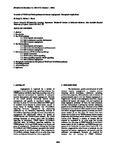Crosstalk of VEGF and Notch pathways in tumour angiogenesis: therapeutic implications.
| dc.contributor.author | Li, J-L | en |
| dc.contributor.author | Harris, AL | en |
| dc.date.accessioned | 2017-11-27T15:57:43Z | |
| dc.date.available | 2017-11-27T15:57:43Z | |
| dc.date.issued | 2009-01-01 | en |
| dc.identifier.uri | http://hdl.handle.net/10026.1/10300 | |
| dc.description.abstract |
Angiogenesis is regulated by a number of angiogenic factors through many signalling pathways. The VEGF pathway and Notch signalling are perhaps two of the most important mechanisms in regulation of embryonic vascular development and tumour angiogenesis. Blockade of the VEGF pathway effectively inhibits tumour angiogenesis and growth in preclinical models. The successes in phase III trials have added anti-VEGF agents to standard cancer therapy in several major cancers. A recent flurry of findings indicate that DLL4/Notch signalling decreases angiogenesis by suppressing endothelial tip cell formation; importantly, blockade of DLL4/Notch signalling strikingly increases non-productive angiogenesis but significantly reduces the growth of VEGF-sensitive and VEGF-resistant tumours. The VEGF pathway interplays at several levels with DLL4/Notch signalling in vasculature. VEGF induces DLL4/Notch signalling while DLL4/Notch signalling modulates the VEGF pathway. DLL4 and VEGF emerge to be the yin and yang of angiogenesis. Combination therapy by blocking DLL4/Notch and VEGF pathways synergistically inhibits tumour growth in preclinical models. Thus, targeting the DLL4/Notch pathway, though still at an early stage, may lead to exciting new therapies for clinical application. | en |
| dc.format.extent | 3094 - 3110 | en |
| dc.language | eng | en |
| dc.language.iso | eng | en |
| dc.subject | Humans | en |
| dc.subject | Ligands | en |
| dc.subject | Neoplasms | en |
| dc.subject | Neovascularization, Pathologic | en |
| dc.subject | Protein Binding | en |
| dc.subject | Receptors, Notch | en |
| dc.subject | Vascular Endothelial Growth Factor A | en |
| dc.title | Crosstalk of VEGF and Notch pathways in tumour angiogenesis: therapeutic implications. | en |
| dc.type | Journal Article | |
| plymouth.author-url | https://www.ncbi.nlm.nih.gov/pubmed/19273260 | en |
| plymouth.issue | 8 | en |
| plymouth.volume | 14 | en |
| plymouth.publication-status | Published online | en |
| plymouth.journal | Front Biosci (Landmark Ed) | en |
| dc.identifier.doi | 10.2741/3438 | en |
| plymouth.organisational-group | /Plymouth | |
| plymouth.organisational-group | /Plymouth/REF 2021 Researchers by UoA | |
| plymouth.organisational-group | /Plymouth/REF 2021 Researchers by UoA/UoA01 Clinical Medicine | |
| plymouth.organisational-group | /Plymouth/REF 2021 Researchers by UoA/UoA01 Clinical Medicine/UoA01 Clinical Medicine | |
| dc.publisher.place | Singapore | en |
| dc.identifier.eissn | 2768-6698 | en |
| dc.rights.embargoperiod | Not known | en |
| rioxxterms.versionofrecord | 10.2741/3438 | en |
| rioxxterms.licenseref.uri | http://www.rioxx.net/licenses/all-rights-reserved | en |
| rioxxterms.type | Journal Article/Review | en |


